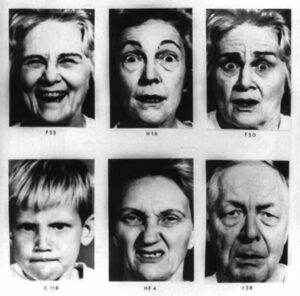WHAT ARE EMOTIONS?
Before finding out whether we can design for emotion, we need to define what emotions are, how they differ from feelings and how they interact with memory.
If you have seen the TV series Lie to Me then you already know a bit about Dr Paul Ekman because the programmes are based on him.
He started studying emotions in the 1950s and he is a leading expert in the science of emotions.
Ekman discovered micro-facial expressions which are very fast changes to our faces. Everyone has the same expression and so they are universal visual clues to someone’s emotions which he calls Emotion Families.
Through evolution, we developed unconscious emotions for survival. Conscious analysis takes time but, for example, fear is involuntary and unconscious so we will react instantly to danger.
We can never know what caused an emotional signal in another person. It might be something we’ve done or something completely unrelated.

Where Do Feelings Fit In?
Dr Ekman says that feelings are a conscious realisation of emotions.
Six Seconds, a non-profit organisation specialising in emotional intelligence, believes the main differences between emotions, feelings and moods is the time they take to happen and how long they last. Emotions last about 6 seconds and feelings last longer. Moods can last seconds, hours and possibly days.
The University of Minnesota’s Introduction to Psychology shows secondary emotions on a diagram with different levels of intensity and pleasantness, which are processed by slower pathways in the brain to primary universal emotions.
Different theories exist about what comes first: the emotion or expressions. Do we feel happy because we smile, smile because we feel happy or do we smile and feel happy simultaneously?
Brazilian psychiatrists and psychologists Pergher et al reviewed how emotions affect memory.
Overall, scientists seem to agree that:
- Emotions are unconscious responses
- Feelings are conscious recognition of emotion
- Emotion intensifies memories and memories intensify emotions
I have been proud to work on engagement ring and wedding ring commissions and I know the memories, feelings and emotions associated with these pieces. But most designs do not have that guaranteed connection which is why understanding more about emotions and feelings is critical to creating memories.
I explore the idea of Memory Sculptures in this YouTube video and I have noticed how emotional my own voice sounds as I talk about my personal sculptures. It is interesting to watch for those fleeting feeling in my own facial expression.
Helpful Definitions:
Anxiety – Fear of an anticipated or actual threat and uncertainty about one’s ability to cope with it
Conscious – aware of what is happening to you
Disgust – We feel disgust when faced with something toxic or unpleasant. Disgust varies in strength and frequency in our lives.
Fear – We feel fear when our safety or wellbeing is threatened. Fear varies in strength and frequency in our lives.
Intensity – Strength of the emotion
Involuntary – cannot be controlled
Micro-facial expressions – very fast changes to our faces. Everyone has the same expression for the same emotion and so they are universal visual clues to how someone is feeling
Perceive/perception – how our brains interpret information
Subconscious – unaware of what is happening until you try to remember
Triggers – Cause of the emotion
Unconscious – you are unaware of what is happening to you
Universal – done by everyone/understood by everyone



